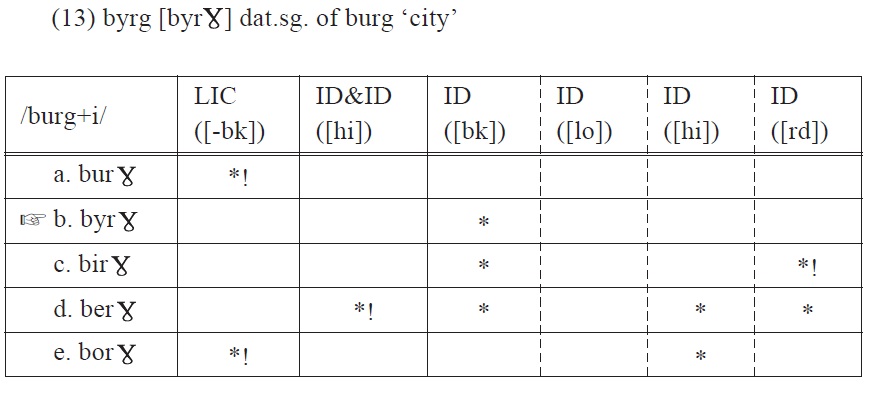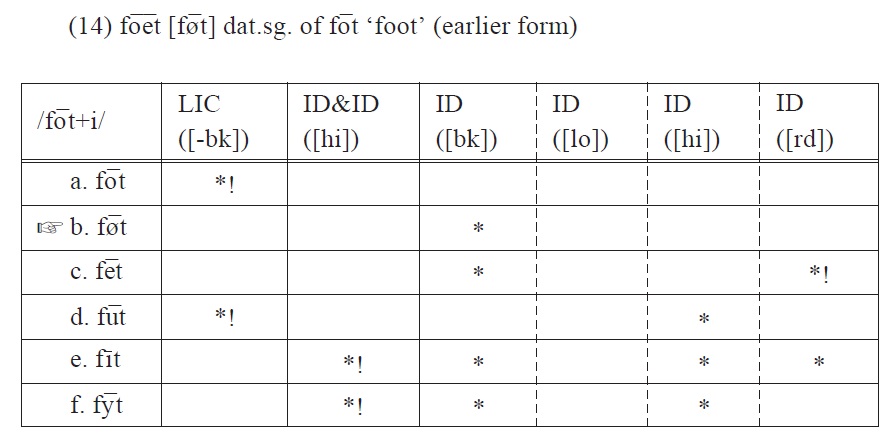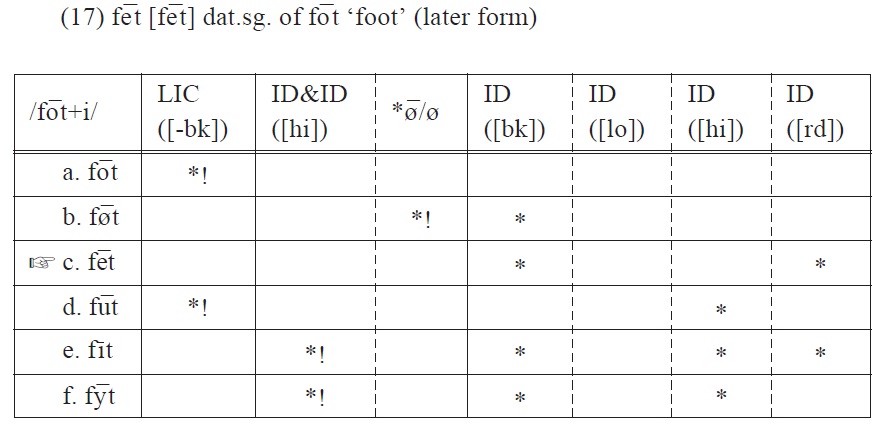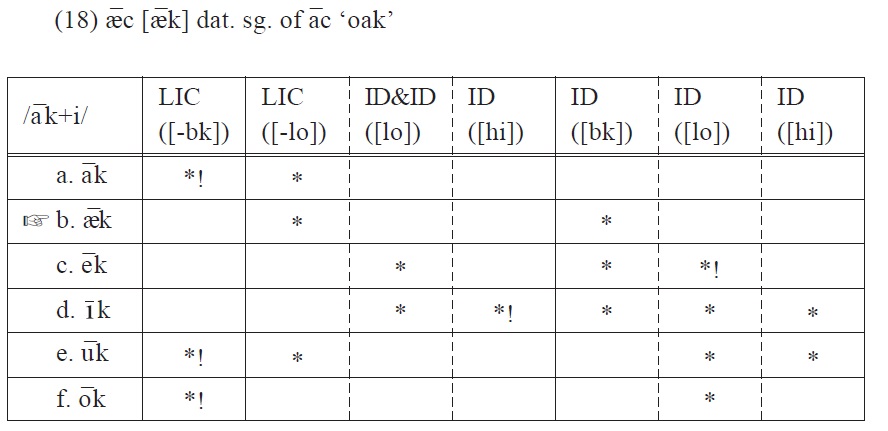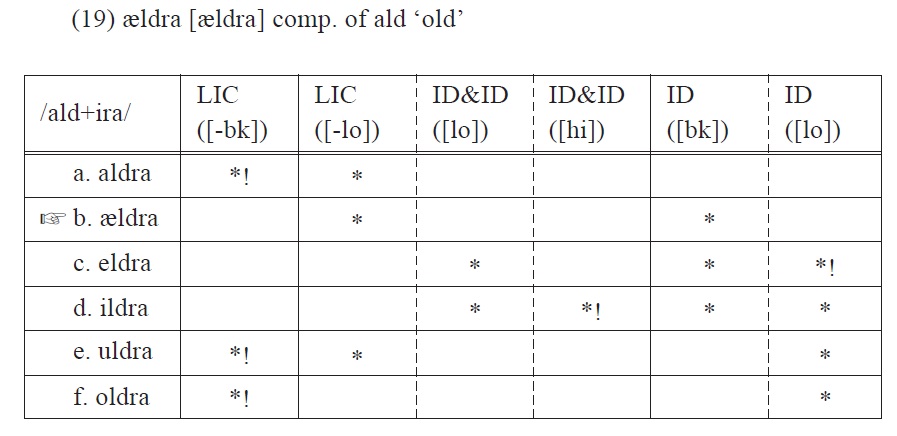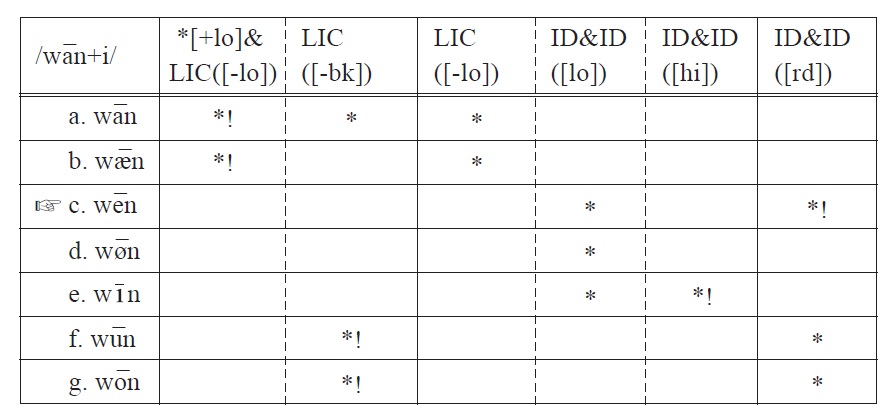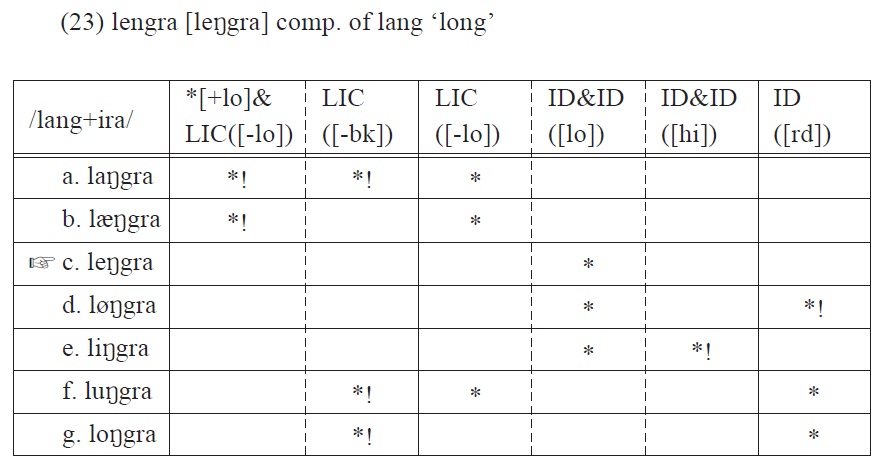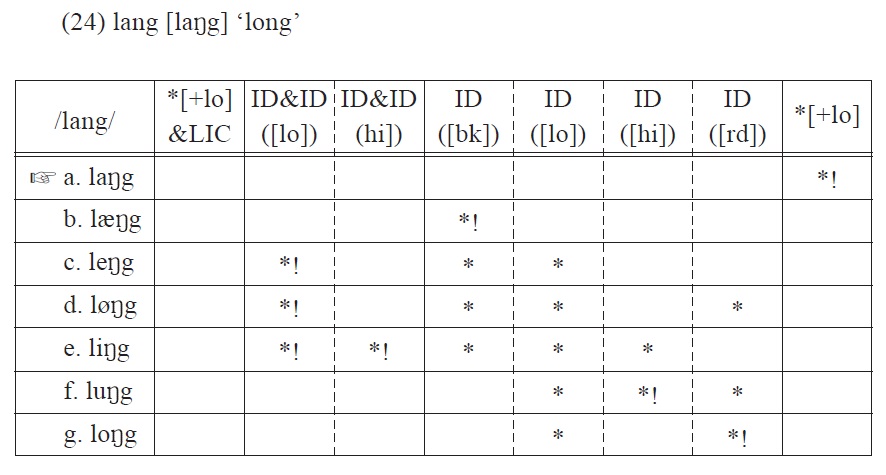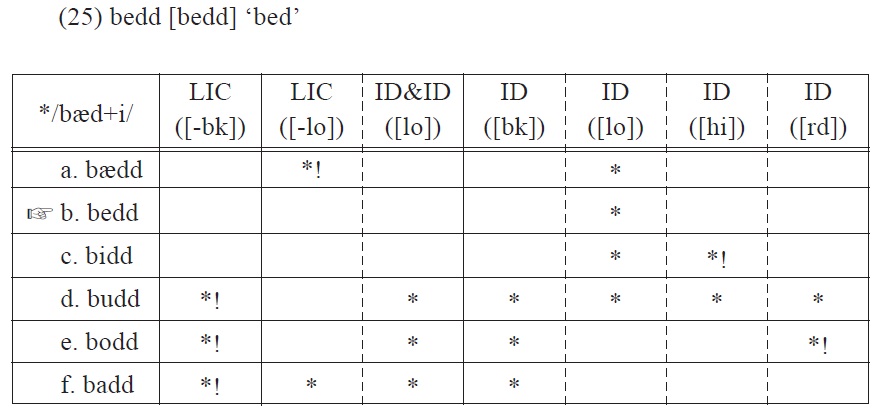


Lass (1994) calls the period from Proto-Germanic (PGmc) to historical Old English (OE) ‘The Age of Harmony’. Among the harmony processes in this period, i-umlaut (or i-mutation) has been considered as ‘one of the most far-reaching and important sound changes’ (Hogg 1992, Lass 1994) or as ‘one of the least controversial sound changes’ (Colman 2005). Such evaluation of i-umlaut in OE is mainly related to its productivity in OE: the number of vowels subject to the change, the creation of entirely new vowel types, and its extensive morphological— either inflectional or derivational — effects (Lass 1994). In addition, the change was not restricted to the certain specific dialect, but occurred regularly in most dialects in OE although there is a slight dialectal variation.
Furthermore, unlike most sound changes in OE, the traces of the effects i-umlaut had on the morphological structures still remain in Modern English as in (1).
The vowel changes caused by i-umlaut play a role in accounting for the irregularity of the noun plurals as well as the semantically related words in Modern English. Hence, the detailed analysis of i-umlaut in OE can contribute to a deep understanding of one of the phenomena that look superficially irregular or unrelated in Modern English.
Although i-umlaut in OE has been often analyzed within the several frameworks of phonological theory from a rule-based approach (Lass and Anderson 1975)to Dependency Phonology (Anderson 2005, Coleman 2005), i-umlaut in OE seems to be less focused on within the framework of Optimality Theory (OT) (Prince and Smolensky 1993, McCarthy and Prince 1995).1,2 Accordingly, we cannot evaluate whether an OT-based analysis has an explanatory power, compared with the previous analyses proposed within the different phonological frameworks.
The goals of this study are i) to explore what motivates i-umlaut in OE and ii) to show how the phenomenon can be analyzed within the framework of OT and how the proposed analysis can account for the phenomenon in a more explanatory way. This study is organized as follows: Section II introduces the data. Section III provides the nature of the trigger and the targets of i-umlaut in OE and explores why the trigger provokes umlaut. An Optimality-theoretic analysis utilizing a positional markedness licensing is proposed in Section IV. Section V discusses the inadequacies of the nonlincensing approaches to i-umlaut in OE. Section VI summarizes and concludes this study.
1Moon (2001) provides an OT-theoretic analysis of i-umlaut in the account of the interaction of i-umlaut and palatalization. However, the analysis deals with only the words in which both phonological changes occur. 2By contrast, we can sometimes find the OT-based analyses of umlaut in the other Germanic languages such as Modern German (Féry 1994, Klein 2000).
During the period of (pre-) Old English, the suffixal i or j in the unstressed syllable caused the stem vowels in the stressed syllable to be fronted or raised.3 The target vowels move upward or forward toward the high front position under the influence of the following high front vowel or glide. Thus a set of vowel changes result and it is collectively called as i-umlaut (or i-mutation).
A close look at the data indicates the results of umlaut are not straightforward as mentioned above. They slightly differ depending on the quality and quantity of the target vowels.4 First, i-umlaut in OE fronts all the back vowels. However, there is disparity in unrounding of the fronted vowels: The fronted mid vowels, [ø] and [ø¯], undergo a subsequent unrounding and respectively become [e] and [ē], whereas the fronted high vowels, [y] and [ȳ], are not subject to unrounding until the end of OE. Although many handbooks often describe [o] and [ō] respectively yield [e] and [ē] from umlaut (Cassidy and Ringler 1971, Mitchell and Robinson 2001), the historical evidence shows we need to posit the stage of the mid front round vowels, [ø] and [ø¯], as a direct result of umlaut (Prokosch 1939, Campbell 1959, Hogg 1992, Lass 1994).5 It is often the case that unrounding is not treated as part of i-umlaut (rule) proper (Lass and Anderson 1975, Jones 1989, Coleman 2005). In this study, I assume two stages in relation to fronting and unrounding.
Second, raising by i-umlaut occurs marginally to front vowels: No long front vowels are raised and only the short low front vowel [æ] is raised to [e].
Third, we can observe some low back vowels are also raised. When they precede a nasal, the low back vowels [ā] and [a] undergo fronting as well as raising and become [ē] and [e]. Otherwise, they are just fronted to [ǣ] and [æ].
What is mentioned so far can be schematized as follows:6
The data of i-umlaut in OE are exemplified in (5) and (6), in which the words are classified depending on the length of the stem vowels.7 The triggers, [i] and [j], once they caused umlaut, are usually lost, but may appear in OE as [e] or [i].8 The words whose trigger is deleted and those which retain their trigger are divided by a semicolon.
3I will use ‘stem’ and ‘root’ interchangeably in this paper since the stem coincides with the root in the data treated here. 4Monophthongs undergo i-umlaut in all dialects of OE, while diphthongs are mutated only in West Saxon (WS) dialect but not in non-WS dialects. This study is restricted to the mutation of monophthongs. 5For more detailed discussion of the motivation for positing the stage of the mid front round vowels, refer to Lass and Anderson (1975). 6Raising of /ā, a/ to [ē, e] before a nasal is not shown in (3) and (4). 7The data and their account in this study are mainly from Campbell (1959), Hogg (1992) and Lass (1994). The data that will be analyzed in this study are mostly Anglian, and examples of WS are excluded. 8The presence or absence of the trigger is usually related to the syllable weight of the stem to which the trigger is added. Research on this issue is beyond the scope of this study and hence we will not discuss this issue here in detail. 9The umlauted vowels [ø¯] and [ø] are usually spelled as <ōē> and
III. Why does i or j Cause Umlaut?
In this section, we explore what initiates i-umlaut in OE. First, let us consider the weak nature of the trigger, which is a suffixal i or j located in an unstressed syllable. Many phonetic studies show the high front vowels16 are inherently difficult to perceive: They are shorter in duration, lower in intensity, and lower in sonority than other vowels (Levitt 1978, Fry 1979, Selkirk 1984, Crystal and House 1988, Pulleyblank 1998, Edwards 2003).
The following two tables display the relative intensity and duration of Modern English vowels and glides.
[Table 1] Relative Intensity of English Vowels and Glides (adopted from Edwards 2003)17
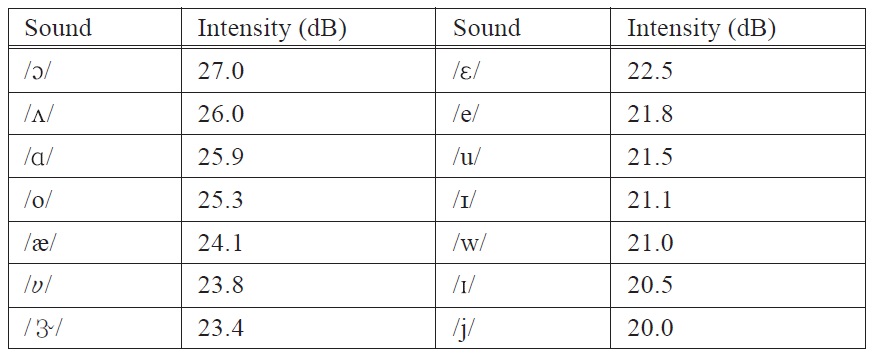
Relative Intensity of English Vowels and Glides (adopted from Edwards 2003)17
[Table 2] Duration of English Vowels (Crystal and House 1988)17
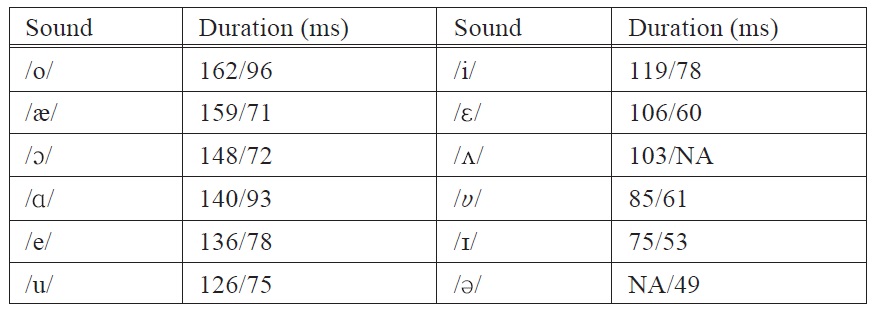
Duration of English Vowels (Crystal and House 1988)17
<Table 1> shows high front vowels (including j) are the lowest in amplitude.18 <Table 2> indicates /i/ is the shortest among the tense vowels, and /Ɩ/ is the shortest among the lax vowels except for /Ə/ in an unstressed syllable.
Sonority of a segment can be a measure of its prominence: The more sonorous, the more prominent, and the less sonorous, the less prominent. Selkirk (1984) suggests that high vowels are the lowest in sonority among the vowels.19 In addition, Pulleyblank (1998) shows that front vowels are less sonorous than back vowels in Yoruba.20 Given these two studies, it is reasonable to assume that the high front vowels including j are the least sonorous and hence least prominent among the vowels.
If the crosslinguistic evidence presented up to this point is applicable to OE, the trigger of i -umlaut in OE, i or j, would be the inherently weakest and hence the most perceptually difficult among the vowels. The trigger of i-umlaut in OE is prosodically disadvantageous, too. It is always found in the unstressed syllable.21 Segments including vowels in the unstressed syllable tend to have shorter duration and lower amplitude than the stressed counterparts. And they tend to lack a salient pitch contour. Furthermore, the trigger is located in the morphologicially weak position, namely, in the suffix. To sum, it is highly probable that the trigger of i-umlaut in OE suffers the perceptual difficulties which are not only inherent but also prosodic and morphological.
Next, take a look at the targets of umlaut. In contrast with the trigger, they are placed in a prosodically and morphologically strong position, i.e. a stressed root syllable. Hence, i-umlaut in OE follows a harmony pattern involving a weak trigger and a strong target. Unlike root-con-trolled harmony, i-umlaut in OE requires that the harmonizing feature spread from the unstressed suffix onto the stressed root vowel.
Then, we can raise a question: Why does the weak trigger cause umlaut and affect the strong targets? I propose that i-umlaut in OE is motivated by perceptual markedness (or weakness) of the trigger that is difficult to identify. Like vowel harmony initiated by perceptual weakness of the trigger (Kaun 1995, Walker 2004, 2005, Revithiadou et al. 2005, Jiménez and Lloret 2007), i-umlaut in OE occurs in order to improve the perceptibility of the weak trigger by extending its high front property to the strong position, i.e. the stressed root vowel.
16Given the vowel system of OE, the short high front vowel /Ī/ in OE may correspond to the high front lax vowel [I] in Modern English and the long high front vowel /Ī/ in OE to the high front tense vowel [Ī] in Modern English. However, it is difficult to confirm such corresponding relationship and so I will compare the high front vowels in general with the remaining vowels in this section. 17Edwards (2003) calculates the averaged values from Levitt (1978) and Fry (1979). The intensity is expressed in reference to /θ/ which has the lowest intensity among the English sounds; it is arbitrarily assigned a value of 1.0. I exclude diphthongs and the consonants except for /w, j/. 18cf. Fry’s (1979) measurements: The five lowest vowels in intensity include /u/ 24 dB, /e/ 23 dB, and /i, u:, i:/ 22 dB. 19Glides are lower in sonority than vowels. 20Walker (2005) cites Pulleyblank’s finding when she briefly mentions the weak trigger effect of umlaut in Old High German. However, she does not provide a detailed analysis. 21Campbell (1959: §204 (2)) claims the trigger of i-umlaut should be in an unstressed syllable. Namely, the trigger in the stressed syllable cannot bring about umlaut. By contrast, Hogg (1992) addresses the presence and absence of stress in the trigger is irrelevant in the operation of umlaut. However, it is reasonable to follow Campbell’s observation given the distribution of the data.
IV. A Licensing Account of i-Umlaut in OE
This section provides an OT-theoretic analysis of i-umlaut in OE that utilizes the licensing approach to vowel harmony proposed by Walker (2004, 2005), Walker notes the weak nature of the triggers in metaphony patterns in Romance languages and develops an approach under which the metaphonic patterns are grounded in improving perceptual weakness. In the analysis of height harmony in Veneto, Walker argues that assimilation of a stressed vowel to an unstressed vowel quality is driven by a positional licensing constraint requiring that perceptually-difficult structure be associated with a strong position. She formalizes a generalized licensing constraint as in (7).
The general schema for prosodic licensing constraints in (7) is grounded in perceptual weakness of the trigger. LICENSE(F, S-Pos) requires that a perceptually difficult feature be affiliated with a perceptually strong position.
In order to formulate the claim proposed in the previous section, I adopt Walker's general schema for licensing constraints and tentatively propose a set of licensing and faithfulness constraints, and their relative ranking, as in (8) and (9).
The hierarchy of the proposed constraints confirms that i-umlaut in OE is driven by the licensing constraints at the expense of the constraints prohibiting featural changes of a vowel, so-called IDENT-IO(F).24 The licensing constraints require the features of the weak trigger to be associated with the vowel in the stressed root syllable, whereby the poor perceptibility of the weak trigger is improved.
In this analysis, I proposed two separate licensing constraints as in (8a) and (8b) instead of one licensing constraint requiring both [+high] and [-back] to be associated with a strong position like LIC([-bk, +hi]). While LIC([-bk, +hi]) makes all the target vowels become [i] or [Ī] regardless of their height and backness, the decomposed licensing constraints prevent all the target vowels from being a high front vowel. Furthermore, the hierarchy between the licensing constraints, LIC([-bk]) ≫ LIC([-lo]), can correctly capture the pattern of i-umlaut in OE: When fronting and raising are possible in an environment, only fronting occurs, and raising can occur only when fronting is vacuously satisfied.
In addition, the weak trigger of i-umlaut in OE attracts the target vowels one step toward the high front position. Fronting and concomitant raising are not allowed except for low vowels before a nasal. Also, the short low front vowel is not raised to high, but to mid. In order to explain such pattern, I propose a set of locally conjoined faithfulness constraints, which block changing more than one vowel feature in the target vowels, and their relative ranking, as in (10) and (11).
How the constraints and their relative ranking proposed up to now work is illustrated in the following tableaux. First, let us look at the word whose stem vowel is /ū/.
LIC([-bk]) requires [-back] feature of the weak trigger to be licensed by spreading to the stressed stem vowel. Candidates (12a), (12e) and (12f), whose stem vowel is back, fatally violate LIC([-bk]) since [-back] feature of the weak trigger is not licensed in the output. Candidates (12b), (12c) and (12d) tie in the satisfaction of LIC([-bk]) since their stem vowels are fronted. (12d) fatally violates ID&ID([hi]) since the values of [back] and [high] are both changed in the output. Between (12b) and (12c), (12b) becomes an optimal output since (12b) is more faithful than (12c).
The short counterpart of the high vowel is explained in the same way, as seen in the following tableau.
Now let us consider the case whose input stem vowel is /ō/.
(14a) and (14d) incur the fatal violation of LIC([-bk]) since [-back] of the trigger is not licensed in the output. On the other hand, the remaining candidates, (14b), (14c), (14e) and (14f), satisfy LIC([-bk]) by associating [-back] feature of the trigger with the stressed stem vowel. In addition to fronting, further raising to a high vowel as in (14e) and (14f) fatally violate ID&ID([hi]) since the values of [back] and [high] are both changed in their outputs. Between the candidates satisfying both LIC([-bk]) and ID&ID([hi]), the more faithful candidate, (14b), becomes the optimal output.
The umlauted mid vowels, [ō] and [o], undergo a subsequent unrounding. In Section 2, I have assumed two stages of change in case of mid vowels: fronting and unrounding. In order to account for the later unrounding, I propose a constraint prohibiting the rounded mid front vowels as in (15) which is ranked above LIC([-bk]). This constraint can be motivated by not only crosslinguistic markedness of the mid front rounded vowels (Ladefoged and Maddieson 1996, Maddieson 2011, UPSID Database)27 but also the absence of the front rounded vowels in the inventory of the vowel phonemes in OE.
Tableau (17) illustrates how (15) interacts with the other constraints and chooses the later form of
(17b), which was the most optimal in the previous stage, is now worse than (17c) since it violates the markedness constraint prohibiting [ø¯] and [ø] which is visibly active at the later stage.
Now let us move onto the words whose input stem has a low vowel preceding a nonnasal consonant. In contrast with the mutated forms of nonlow vowels which satisfy both of the licensing constraints, mutation of the low vowels always violate LIC([-lo]) since the low vowels are just fronted without raising when they precede a nonnasal consonant. This is correctly captured by the proposed hierarchy of the constraints, as seen in the following tableau.
Candidates (18a), (18e) and (18f) fatally violate LIC([-bk]) since their stem vowel is not fronted. Among the candidates with the stem vowel fronted, (18b) best satisfies the hierarchy of the constraints: (18d) violates both ID&ID([lo]) and ID&ID([hi]), which is fatal, while (18c) is less faithful than the optimal output (18b).
Mutation of the short low back vowel is explained in the same way that its long counterpart is explained as seen in (19).
In contrast with the low back vowels discussed above, the low back vowels preceding a nasal are mutated to [e] and [ē], not to [æ] and [ǣ]. They undergo additional raising. Although there have been controversies on what is the intermediate stage of the change from [ā]/[a] to [ē]/[e]28 and what brings about raising of [ā]/[a] to [ē]/[e]29, what is not changed is that [ā] and [a] are not allowed to appear before a nasal in the umlaut environment. However, we cannot simply posit a markedness constraint like (20a) in order to rule out a prenasal low back vowel since the low back vowels are allowed to appear in the non-umlaut environments, as in lang ‘long’ and mann ‘man’. In order to account for such distributional difference, it is necessary to posit the local conjunction of LIC([-lo]) and the markedness constraint in (20a) in a suffixed form, as in (20b). The locally conjoined constraint, *[+lo]&LIC([-lo]), prohibits a prenasal low back vowel in the umlaut environment.
How (20b) and (21) work is illustrated in the following tableau.
Candidates, (22a), (22f) and (22g), which have a back vowel in the output, are ruled out due to the fatal violation of LIC([-bk]). Among the remaining candidates which satisfy LIC([-bk]) by fronting their root vowel, (22c) best satisfies the hierarchy of the constraints: (22b) fatally violates *[+lo]&LIC([-lo]) since *[+lo] and LIC([-lo]) are both violated; (22d) is less faithful than (22c), which is fatal; (22e) incurs an additional violation of ID&ID([hi]) compared with the optimal output, (22c).
Mutation of a short vowel /a/ is explained in the same way that its long counterpart is analyzed, as in (23).
Compared with
Finally, let us consider the case of mutation of the front vowel. Among the front vowels, only the short low vowel is subject to mutation.
When the stem vowel is front as in (25a), (25b) and (25c), LIC([-bk]) is vacuously satisfied and hence LIC([-lo]) is visibly active in selecting an optimal output among them. When the input vowel is not raised, it incurs the fatal violation of LIC([-lo]) as in (25a). Between the candidates that obey both of the licensing constraints, the more faithful candidate, (25b), is chosen as an optimal output.
Up to this point, we have shown that the proposed constraints and their relative ranking in the hierarchy explain why the weak trigger i or j provokes umlaut in OE and capture that fronting of back vowels and raising of the front vowel are not distinct processes, but differential responses to features of the weak trigger, i.e. [-back, +high].
22I made her general schema short for ease of exposition. 23In this study, I modify Walker’s (2004, 2005) general schema for licensing constraints. According to Walker’s definition which is not shown in (7), the licensing constraints check licensing of the weak trigger in the output. By contrast, i-umlaut in OE requires the licensing of the weak trigger in the input. This kind of modification is also supported by Jiménez and Lloret (2007). However, we do not need to revise Walker’s definition if we assume the stage in which the high vowel is not deleted. 24For expositional convenience, I use IDENT-IO[F](ID([F])) as a cover term constraint for a set of constraints that require a featural identity of a vowel. 25In this paper, I do not include the constraints that account for the deletion of the trigger in the tableaux, for ease of exposition. Deletion of the trigger is often treated under the name of High Vowel Deletion (HVD). Moon (1996) explains deletion and retention of high vowels in pre-OE by the interaction of constraints such as ONS, a set of the decomposed MAX(V) constraints, and a set of alignment constraints. The interaction of the constraints relevant to HVD and i — umlaut can be illustrated as follows (Only the candidates satisfying Align(Infl, L FT, R) are provided in the tableau, due to lack of space. For more about HVD, refer to Moon (1996)): 26Hereafter, we will not deal with the candidates violating LIC([-lo]) when we analyze the words whose input stem has a non-low vowel. They vacuously satisfy LIC([-lo]). 27According to their survey, front vowels are unrounded and back vowels are usually rounded in the great majority of the world’s languages, while only a small minority of languages have front or central rounded vowels. In addition, an analysis of the UPSID database shows mid front rounded vowels are less frequent than high front rounded vowels, which may indicate the former is more marked than the latter. Such difference in markedness may allow us to explain why unrounding of the umlauted high front rounded vowels is delayed until the end of OE. Their frequencies can be compared in the following table: 28On the issues, refer to footnotes 11 and 14 in this paper. 29For example, Hogg (1992) and Lass (1994) claim the raising is caused by the following nasal (prenasal raising), while Campbell (1959) states the following nasal palatalized by the i-umlaut trigger brings about a further change of [æ] to [e]. Given that raising of the nasalized vowels is frequent in Germanic and WGmc, and there is no supporting evidence of the raising effect of the palatalized consonant in OE, it seems to be more plausible to follow Hogg (1992) and Lass (1994). 30Due to lack of space, the constraints that are not crucial in the selection of an optimal output are not shown in the tableau.
V. Nonlicensing Approaches to i-Umlaut in OE
In this section, we discuss the possible problems that we can encounter when we adopt a nonlincensing approach to i-umlaut in OE. First, let us consider the spreading approach. As vowel harmony is often treated as featural spreading, i-umlaut in OE can be treated as featural spreading. Featural spreading is embodied as several kinds of constraint within the framework of OT: SPREAD(F) (Padget 1995, Kaun 1995), AGREE(F) (Bakovic 2000), Match(F) (McCarthy 2003), ALIGN(F) (Kirchner 1993, Archangeli and Pulleyblank 1994), and SHARE(F) (McCarthy 2009ab). Although these constraints have different implications and predictions, they can be considered as the same in that they demand featural spreading.31 Moon (2001) proposes Spread Front in the account of interaction of i-umlaut and palatalization in OE and revises it into an alinement constraint, AlignR([-bk], vowel) in the same study. Unlike the licensing constraints proposed in the previous section, either Spread Front or AlignR([-bk], vowel) cannot account for why i-umlaut in OE favors a hight front vowel or a glide trigger in the unstressed syllable. They just give an order of spreading on the syllable left or aligning a segment to the left without providing a phonetic motivation in the umlaut.
An alternative positional faithfulness approach to vowel harmony is also inadequate to explain i-umlaut in OE. Positional faithfulness (McCarthy and Prince 1995, Beckman 1998 among others) expects harmony sensitive to a strong position, namely, either to a stressed syllable or to a root vowel. Under positional faithfulness, root faith is more important than affix faith (IDENT-IOroot≫IDENT-IOaffix), and faithfulness in a stressed syllable is more important than faithfulness in an unstressed syllable (IDENT-IOó≫IDENT-IOŏ). Positional faithfulness plays a crucial role in accounting for harmony initiated by a prosodically and/or morphologically strong trigger. Accordingly, harmony driven by perceptual weakness of the trigger would require the fixed ranking of the positional faithfulness constraints to be reversed (Walker 2005, Jiménez and Lloret 2007, Kaplan 2008). Furthermore, given extensive crosslinguistic evidence and functional grounds of positional faithfulness, it is not desirable to posit the reversed hierarchy of the constraints such as IDENT-IOaffix≫ IDENT-IOroot (Walker 2005). I-umlaut in OE would also be in the same dilemma. However, the licensing account proposed in Section 4 allows us to maintain the universal generalizations captured by positional faithfulness. In the account, positional faithfulness is not just visibly active in i-umlaut in OE.
31For more detailed discussion of the advantages and disadvantages of each constraint, refer to McCarthy (2003, 2009a) and Poliquin (2006).
In this study, it has been suggested that the main characteristic of iumlaut in OE is that it is provoked by a weak trigger and targets a segment in the strong position. In order to account for this pattern, I relied on the licensing approach to vowel harmony and provided a formal analysis couched in OT. While the rule based analyses or the analyses based on spreading (or alignment) and positional faithfulness fail to incorporate the perceptual motivation in i-umlaut in OE, the proposed licensing account is more successful on explanatory ground in that it can easily capture the phonetic motivation for i-umlaut in OE: the inherently, prosodically and morphologically weak trigger promotes assimilation of the vowel in the stressed root syllable in order to improve its perceptibility. The main insight shown in the licensing account proposed in this study is that umlaut in OE is driven by a desire to place [-back] or [-low] in a prominent position, i.e. the vowel in the stressed root syllable rather than a desire to spread on syllable to left or to align a segment to the left. That is, it has been shown that the goal of i-umlaut in OE is to propagate [-back] or [-low] to the target in the strong position rather than to simply spread or align [-back] or [-low].
Unlike metaphony patterns in Romance languages, umlaut in OE makes the stem vowels move one step toward the high front position, not become a front vowel in one fell swoop. The target vowels also do not undergo both of fronting and raising, except for the prenasal low vowels. In order to account for this pattern, I have proposed the separate licensing constraints and introduced local conjunction. In the proposed analysis, it is shown that the interaction of the licensing constraints, the locally conjoined constraints, some markedness constraints and IDENT-IO(F) constraints correctly yield optimal outputs. One and the same hierarchy of the constraints proposed in this study allows us to provide an analysis capturing that fronting of back vowels and raising of front vowels are not distinct processes, but differential reponses to features of the trigger.
Finally, in this study we have shown that i-umlaut in OE can be newly added to a typology of vowel harmony instigated by perceptually weak triggers.





